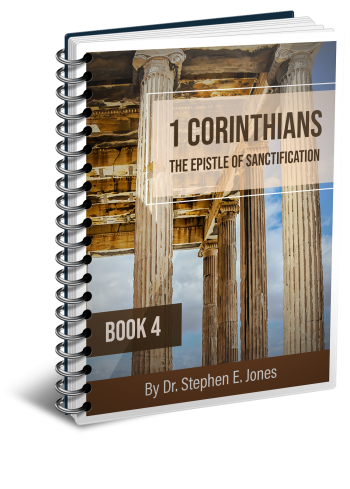Latest Posts
View the latest posts in an easy-to-read list format, with filtering options.

An in-depth commentary/study on chapters 14 through 16 of First Corinthians.
Category - Bible Commentaries

There are two types of death. The first is the penalty for Adam’s sin, and the second is the penalty for one’s own sins. Since we, with Paul, “die daily,” we are already experiencing the second death, for it is only by dying that we are given life. Paul says in Rom. 6:7, “he who died has been justified from sin” (The Emphatic Diaglott). Death pays the penalty for Adam’s sin, but mere death from mortality does not justify anyone from his own sin. It requires a second type of death to justify anyone.
Jesus paid the penalty for Adam’s sin by His death on the cross. When we identify with Him in the likeness of His death, we do not die suddenly as mortals. Instead we experience a second type of death while we are yet alive. This is the death of the flesh in a baptism of fire by means of the Holy Spirit. It is our “lake of fire,” the second death.
The vast majority of people on earth, however, live their lives without ever having faith in God’s promise, nor do they appropriate and apply Christ’s blood upon the altar of their hearts. Yet because God’s New Covenant promise was to save all mankind, He can do so only if there is provision for these unbelievers in the age to come.
Because God can neither lie nor fail, all will indeed be saved. However, the timing of each person’s salvation (in a practical sense) is different. Those not justified by faith during their life time will indeed confess their allegiance to Him at the Great White Throne where there will be no atheists and where all resistance will crumble. So God will not fail to keep His New Covenant oath to be our God and to make us His people (Deut. 29:12, 13).
What, then, is the condition of those who abide in the “lake of fire” during the age of judgment? Are they mortal? Jesus said that in the general resurrection, believers will be raised to “a resurrection of life,” but that the unbelievers will be raised to “a resurrection of judgment.”
If these unrighteous people are not given “life” at that point, how can death (mortality) be cast into the lake of fire? Would they not remain mortal while paying the penalty for their own sin in the lake of fire?
It is apparent that no one will die during that age of judgment. Not only will they live but they will also labor to pay off the debts that accumulated during their life time on earth through sin. All sin is reckoned as a debt, and because unbelievers did not avail themselves of Christ’s gracious provision to pay off their debt, they will have to work, as best they can, to pay their debt, as the law demands.
Yet no man can fully pay his own debt to the law by his own righteous acts, because in the ultimate sense, no good act can pay for an act of sin. Only minor sins can satisfy the law through restitution payments. But on a deeper level, we have all committed sins worthy of death.
For example, hatred is the same as murder (Matt. 5:21, 22). Lust is adultery (Matt. 5:27, 28). Covetousness is idolatry (Col. 3:5). God’s standard of righteousness is very high. Just because a person has never killed someone does not mean he or she is innocent of murder. Murder, adultery, and idolatry are crimes worthy of the death penalty.
The heavenly standard of righteousness, then, cannot so easily be met, for God expects nothing short of absolute perfection. Once a person has committed his first sin, he is no longer righteous and cannot return to a state of righteousness on his own. He is already worthy of death, and the penalty can only be satisfied by the death penalty. Hence, he must experience the second death.
That is why no man can be justified apart from the cross of Christ. He must experience the second death, either in this life time or the next.
So if death is cast into the lake of fire, does that mean that those who are being judged as unrighteous ones are given “life” along with the believers? Obviously not, but then how is it that they can live until the Creation Jubilee—which I believe will occur 42,000 years later? Is that not evidence of immortality?
No, it is not. Consider the fact that the patriarchs lived to be hundreds of years old, and yet they were mortal. Their life spans were limited to under a thousand years. At creation, their physical bodies were healthy and perfect. When the cells of their body wore out, their bodies were designed to replace them with new cells indefinitely. They had at least the potential to live indefinitely, unless they fell off a cliff and as long as they were not murdered by someone else.
The point is that at the Great White Throne, all who are resurrected, both believers and unbelievers, are given some level of life. The believers, after experiencing some “fire”, will be given true immortal life. But the rest will be given a lower level of life that is more comparable to what we see with the early patriarchs. Their cells will be renewed as they wear out, and this will be made possible by good nutrition in a good environment. Yet this will be a natural long life.
Thus, while experiencing the second death, they will not die from mortality, but neither will they be truly immortal in the full sense of the word. They must live to serve their full sentence under the authority of the immortals. They must live to grow spiritually, learning righteousness by the example of those in authority over them.
But someone may ask, “If they have already bowed their knees to Jesus Christ, and if they have already confessed Him as Lord to the glory of God the Father, why would they not be given immortality immediately? Did not Jesus pay for their sins at the cross?”
Well, look at our own example. When you confessed Christ by faith, did you receive immortal life in yourselves? Did you become immortal, or did you continue to age? Have you even reached the point where your cells no longer wear out and die? Look at history. Given enough time, everyone in past generations has died, even if they believed that they would never die.
What manner of life, then, was given to us when we first believed? The new life in us was the life of the New Creation Man, also called the “inner man” (Rom. 7:22). The old man, who has been sentenced to death since the time of Adam, cannot come into immortality. It will surely die.
But believers are given life through a change of identity, where they are no longer their Adamic self which came through their fathers but are now a new creature, a new self, that has a different Father. We are begotten by the Spirit of God, and so Paul speaks of “Christ in you, the hope of glory” (Col. 1:27).
This is your Christ-identity, the anointed one who is part of the body of Christ, and it is this new self that has received the same quality of immortal life as his Father.
At the general resurrection, the unbelievers will be given new bodies, but they will be Adamic bodies, not Christ-bodies. Only the believers will be given Christ-bodies that are inherently immortal, once they have come through the purifying fire that brings them to spiritual maturity.
But all of the new believers—those who did not confess or profess Christ until they were summoned to the Great White Throne—will have to grow into maturity in the same manner that the rest of us have had to grow during our life time on earth. No one gets immortality except by the established order and procedure.
That will take time.
How long will this time be? In my view, it is based on the law of Jubilee. The Jubilee trumpet was to be blown after seven weeks of years, that is, after 49 years (Lev. 25:8). At the end of 49 years—actually, ten days into the 50th year on the Day of Atonement—the Jubilee trumpet was to signal the end of all debt and slavery (Leviticus 25:10). The year of Jubilee was the 50th year, which also served as the first year of the next Jubilee cycle.
Hence, the Jubilee cycles, when calculated in multiples of ten, come to 490 years, as in Daniel’s seventy weeks of years. Forty Jubilees is 40 x 49, or 1,960 years, not 2,000 years. A hundred Jubilees is 100 x 49, or 4900 years.
In my view, God’s plan for creation’s restoration called for a Creation Jubilee cycle of 49,000 years. A day is as a thousand years (Psalm 90:4; 2 Peter 3:8), and furthermore, a day is also a year (Num. 14:34; Ezekiel 4:5, 6). Putting these elements of biblical timing together, we can see that we are now coming to the end of the first six days/years of 1000 years each.
The Great White Throne judgment will occur at the end of the first great “week” of man’s history since Adam’s sin. This leaves another six “weeks” to go. Six creation weeks are 42,000 years. Keep in mind that it is my belief that these weeks are not dated from creation itself but from Adam’s sin. If these are to be dated from creation itself, then we must contemplate how much time passed before Adam’s sin. The Bible does not say, but many like to speculate on such things.
In my view, the underlying purpose of the law of Jubilee is to limit judgment for sin/debt, so that in the end all may return to their lost inheritance. Without sin and without a loss of inheritance, there would be no practical purpose for a law of Jubilee. Hence, a Creation Jubilee cycle was designed to address this problem and should therefore begin with the day that Adam lost his inheritance through sin/debt.
Because the law of Jubilee was God’s way of limiting liability for sin, it extended grace to all who still owed on their debts. The law of Jubilee cancelled all remaining debt whether men deserved it or not. That is the law of grace.
So I believe that the age of judgment will last 42,000 years, ending with the final declaration of the Jubilee after 49,000 years of human history. When that final Jubilee trumpet sounds, then God will be all in all and His New Covenant oath will be fulfilled.